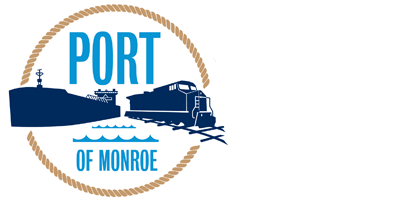The Port of Monroe’s Turning Basin dock was the site of two unique transloads in the last week.
First, the Port and DRM Terminal Management completed the roll-off of two specialized heavy-haul trailers. The tug Ecosse delivered the barge from Windsor, Ontario in a unique cross-border transfer.
The Port and DRM partnered with McKeil Marine Limited, Buckingham Trucking, and GWS Forwarding to efficiently and safely roll-off the trailers. The operation was the first of its kind to take place at Monroe, and the Port/DRM are excited to provide roll-on roll-off services for both domestic and international cargo operations in the future.
The second operation involved the transfer of a 390-ton generator stator from a barge to a specialized rail car.
The stator was delivered from Schenectady, New York to Oswego New York via the NYS Canal system and barged to Monroe by the Ashton Marine tug Meredith Ashton.
A specialized crane was erected at the Port by Barnhart Crane & Rigging and Maxim Crane.
The stator is the same piece that was imported through the Port onboard the heavy-lift vessel Happy Ranger in 2019 and exported from the Port in 2022 for reconditioning. The Port has now been the site of three transfers involving the same component, with each operation being unique.
The Port was proud to work alongside HLI, Barnhart Crane & Rigging, Ceres Barge, Ashton Marine, Canadian National Railway, Mid American Group, Maxim Crane, GE Vernova, Ashton Marine, Fracht, DTE, and other partners in the handling of the stator.
The Port’s turning basin dock dates back to the original construction of the Port which took place in the 1930s and 1940s. The current turning basin rail spur was built in 2019 and allows components like the stator to be transferred directly from ship to rail.
Future RORO and heavy-lift operations at the turning basin dock will be enhanced by new infrastructure.
As part of the Port’s Lake Erie Renewable Energy Resilience Project, the turning basin dock will be fully rehabilitated, including a new concrete cap and construction of a seawall which collapsed in 2022. The project was funded by the U. S. Department of Transportation through the Port Infrastructure Development Program in 2022. It is the largest funding award received in the Port’s history.









